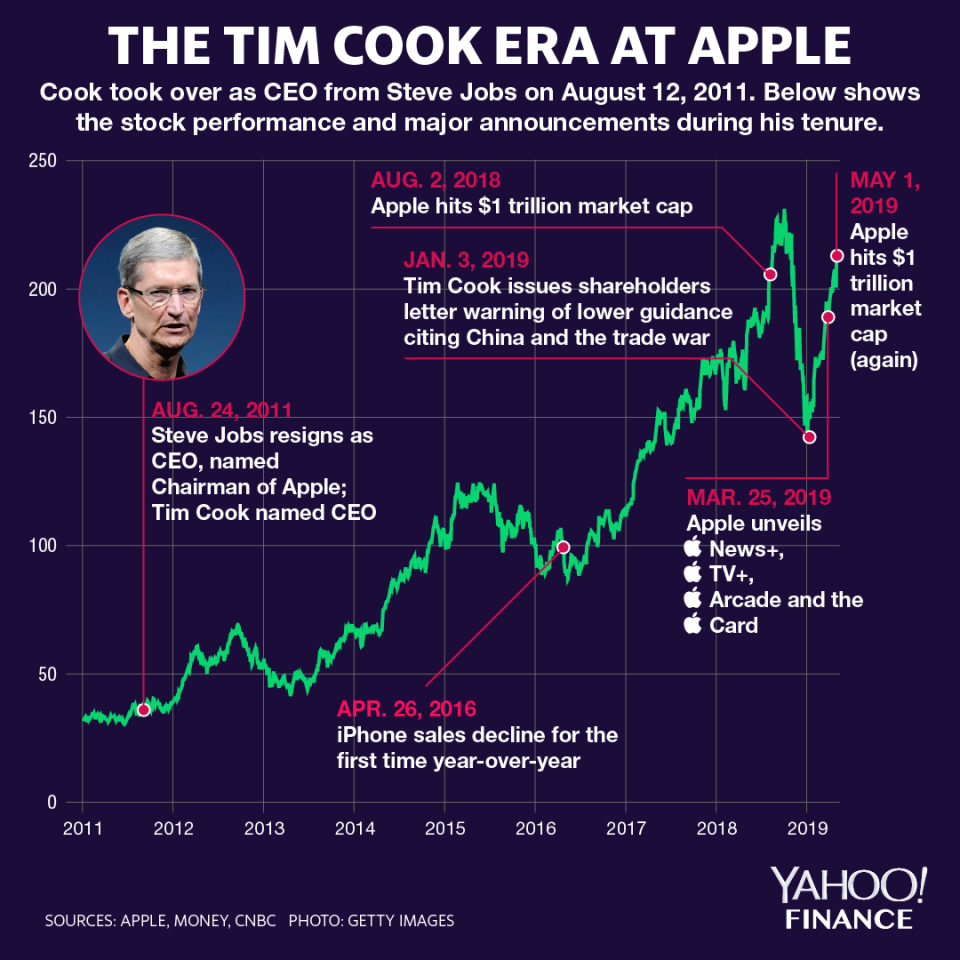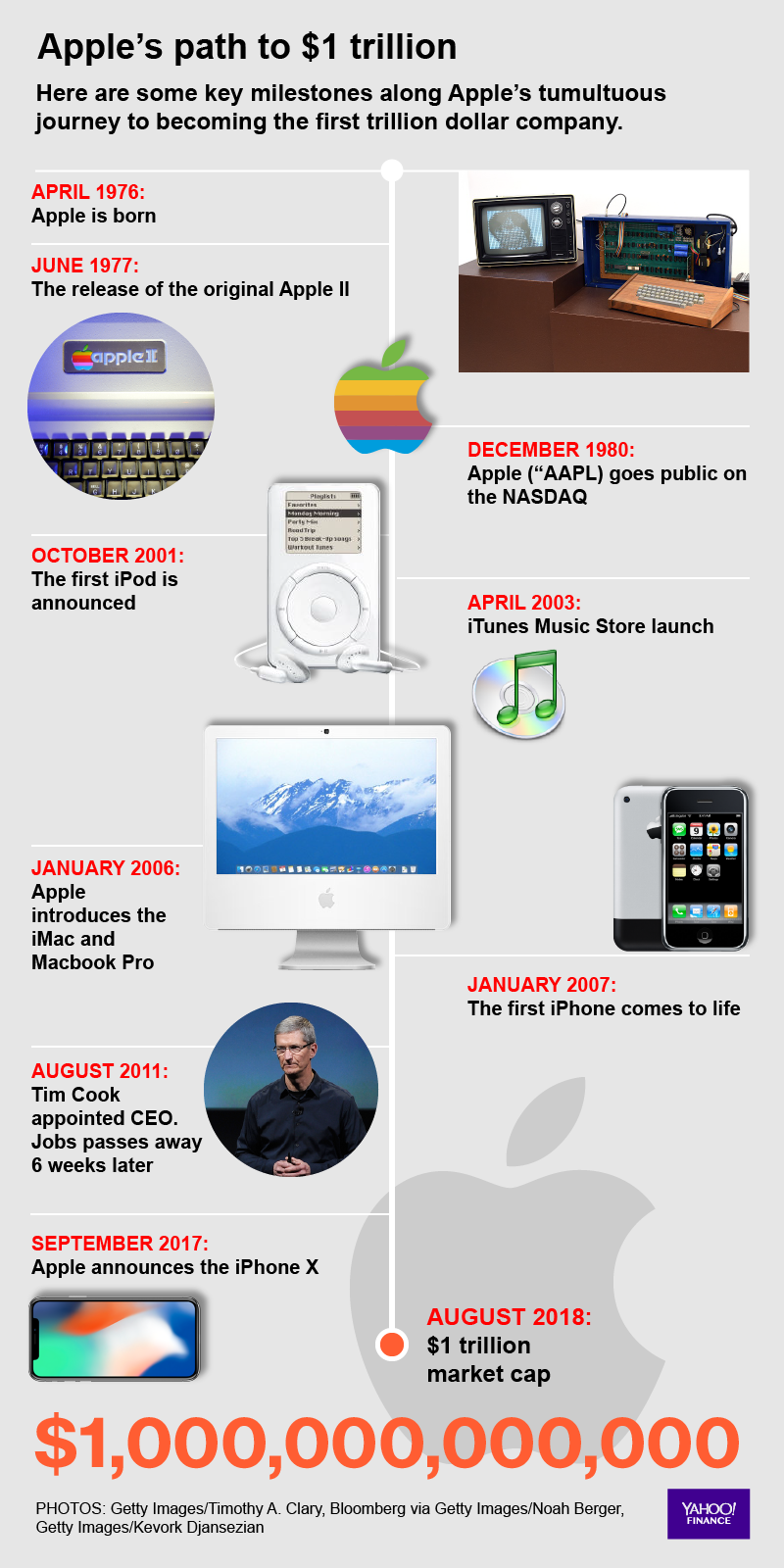Apple’s path to $1 trillion
Apple’s valuation hit $1 trillion once again Wednesday on the heels of the company’s better-than-expected earnings report that exceeeded Wall Street’s expectations on both the top and bottom lines.
The company reached the milestone when shares traded above $210.31 Wednesday morning. The tech giant’s valuation can be calculated by multiplying the price of a single share by 4,754,986,000, the number of shares outstanding.
Apple (AAPL) was the first U.S. company to reach a market cap of $1 trillion on August 2, 2018, but had lost the title at the end of last year after expressing concerns around slowing iPhone sales. And in January, the company spooked investors after giving its first revenue warning in 16 years, blaming slowing growth in China and the ongoing trade war with the world’s second largest economy.
Microsoft (MSFT) and Amazon (AMZN) have also touched trillion-dollar territory, but Apple has stayed at the top the longest. The latest $1 trillion milestone comes after Apple’s services industry — including iCloud, iTunes, the App Store, Apple Pay, AppleCare and Apple News+ — saw 16% growth year-over-year. Apple is also expanding its services segment with a new Apple TV+ streaming service, which will aim to rival Netflix.

Here are the key milestones along Apple’s tumultuous journey to becoming the first trillion dollar company in America.
April 1976: Apple is born
Steve Jobs and Steve Wozniak, after dropping out of Reed College and UC Berkeley respectively, cobbled together the Apple I computer in Jobs’s garage, which they would go on to sell without a monitor or keyboard. The company eventually became incorporated on January 3, 1977.
June 1977: The release of the original Apple II
The Apple II revolutionized the personal computer industry. The device’s color graphics and user-friendly design were considered to be game-changing innovations at the time. In April 1977, the now-defunct Byte magazine predicted that the Apple II “may be the first product to fully qualify as the ‘appliance computer’ … a completed system which is purchased off the retail shelf, taken home, plugged in and used.” In its March 1978 review, Byte concluded, “For the user that wants color graphics, the Apple II is the only practical choice available in the ‘appliance’ computer class.”
December 1980: Apple goes public
Average investors get to take a bite out of Apple, which was still considered a risky upstart at the time. The company sold 4.6 million shares at $22 per share under the stock symbol “AAPL,” on the NASDAQ. The public offering generated more capital than any other debut since Ford (F) in 1956.
April 1983: A new CEO takes the helm
Jobs poaches John Sculley, who was the president of Pepsi at the time, to become the tech company’s CEO. They banked on his marketing expertise to drive sales, especially for the new Lisa computer.
1985: Wozniak and Jobs leave
Both founders leave Apple for different reasons. Wozniak is uninterested in the day-to-day operations of the business. Jobs, who had wooed Sculley to the company, finds himself in conflict with the CEO and leaves as well. Jobs goes on to found his own company NeXT Software.
February 1997: Jobs returns
Apple finalizes its deal to buy NeXT Software for $427 million. Jobs rejoins Apple as interim CEO and replaces Gil Amelio, who is ousted by the board of directors.
November 1997: The Apple Store
Apple launches its own online retail store. It becomes the new direct sales avenue that ties into its build-to-order vision for manufacturing.
May 2001: A push into brick and mortar
Apple announces its line of Apple retail stores, which have since become an integral part of the company’s footprint. Apple stores are now blossoming into sprawling “Town Squares.”
October 2001: The first iPod
Apple introduces its first portable digital audio player. The 6.5-ounce, 5-gigabyte device is capable of storing 1,000 downloaded songs. The first iPod retails for $399.
April 2003: iTunes makes a splash
iTunes Music Store, a platform that allows customers to purchase songs for 99 cents each, without subscription fees, launches in the U.S. It goes live with over 200,000 songs from artists represented by most major music labels. The store sold its 1 billionth song three years later in February 2006.
January 2006: iMac and Macbook Pro come to life
The company’s first Intel-based machines are introduced to the market.
January 2007: Apple enters the cellphone market
After years of speculation, Jobs announces the iPhone, a device that combines the first widescreen iPod with a mobile device. The first version became available in June 2007.
January 2010: The iPad takes the stage
The company announces the half phone-half computer device. Though there were fears of cannibalization of its other products, Apple’s 2010 financial results mentioned a “halo” effect — iPad sales led to more Mac sales.
August 2011: Tim Cook appointed CEO
After suffering from pancreatic cancer, Jobs decides to step aside from his duties as CEO. He appoints Tim Cook, who had joined Apple in 1998 as senior vice president of worldwide operations.
October 2011: Jobs dies
Just six weeks after resigning as CEO, Jobs dies due to complications from cancer.
May 2014: Beats acquisition
Apple acquires rapper Dr. Dre’s popular headphone and speaker company, in addition to its streaming service Beats Music.
September 2014: Apple announces Apple Watch
The Apple Watch is the first new product since Jobs’s departure. It receives mixed reviews, as it can’t function beyond basic features without WiFi or Bluetooth.
September 2017: Apple announces three new iPhones
The iPhone 8, iPhone 8 Plus and the iPhone X are announced at the Steve Jobs Theater in the Apple Park campus. The iPhone X, with a $1,000 price tag, commemorates the iPhone’s 10th anniversary.
August 2018: Market cap hits $1 trillion for the first time.

Melody Hahm is a senior writer at Yahoo Finance, covering entrepreneurship, technology and real estate. Follow her on Twitter @melodyhahm.
Read more:
What it’s like to glamp on New York City’s Rockaway peninsula
26-year-old launches Instagram-fueled fast fashion brand
Inside the exclusive supper club in a 1-bedroom NYC apartment
A father-son duo is revolutionizing this $20B industry one BBQ at a time
Women’s-only club The Wing opens its doors for a special occasion
25-year-old’s startup is making fast fashion even faster

